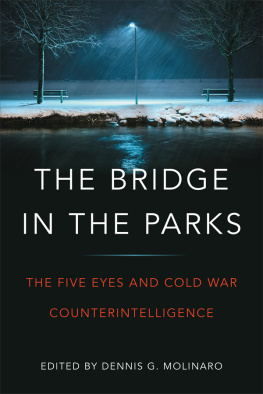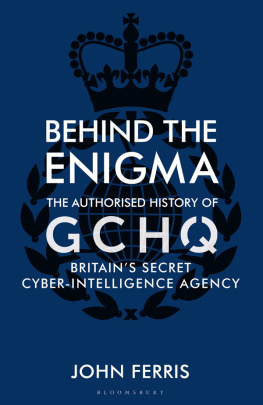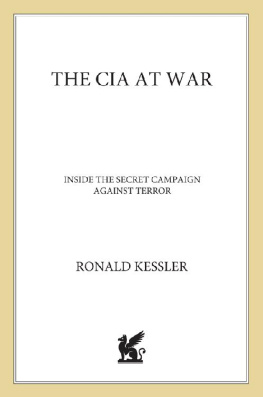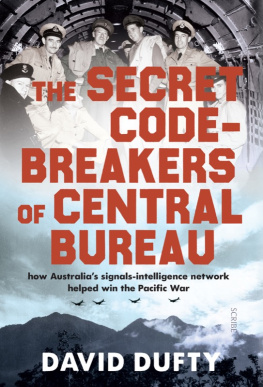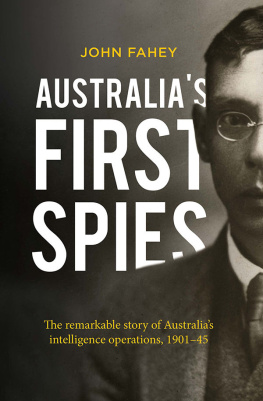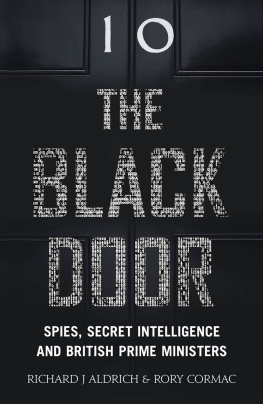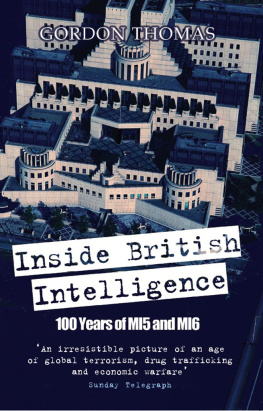

Richard Kerbaj is a BAFTA-winning and twice Emmy-nominated filmmaker and writer who has specialised in investigating matters of national security for more than fifteen years. He has written extensively about the impact of counterterrorism and counterespionage on intelligence agencies.
Richard is also a multi-award-winning journalist who was the security correspondent for the Sunday Times between 2010 and 2020. Prior to that, he worked for The Times as an investigative reporter and foreign correspondent, and for The Australian. He has written and produced international award-winning documentaries, including My Son the Jihadi, Hunting the KGB Killers, about the murder of Russian dissident Alexander Litvinenko, and Unmasking Jihadi John: Anatomy of a Terrorist.
The Secret History of the Five Eyes is his first book.

First published in the UK by Blink Publishing
an imprint of Bonnier Books UK
4th Floor, Victoria House
Bloomsbury Square
London WC1B 4DA
England
Owned by Bonnier Books
Sveavgen 56, Stockholm, Sweden
www.facebook.com/blinkpublishing
twitter.com/BlinkPublishing
First published in hardback and trade paperback in 2022
Hardback ISBN: 978-1-78946-503-7
Trade paperback ISBN: 978-1-78946-555-6
Ebook ISBN: 978-1-78946-556-3
Audiobook ISBN: 978-1-78946-557-0
All rights reserved. No part of this publication may be reproduced, stored in a retrieval system, or transmitted in any form or by any means, without the prior permission in writing of the publisher, nor be otherwise circulated in any form of binding or cover other than that in which it is published and without a similar condition including this condition being imposed on the subsequent purchaser.
British Library Cataloguing-in-Publication Data:
A CIP catalogue record for this book is available from the British Library.
Design by www.envydesign.co.uk
1 3 5 7 9 10 8 6 4 2
Text copyright Richard Kerbaj 2022
The right of Richard Kerbaj to be identified as the author of this work has been asserted by him in accordance with the Copyright, Designs and Patents Act 1988.
Every reasonable effort has been made to trace copyright-holders of material reproduced in this book, but if any have been inadvertently overlooked the publishers would be glad to hear from them.
Blink Publishing is an imprint of Bonnier Books UK
www.bonnierbooks.co.uk
To Marine, Leo, Dom and to either Margaux or Nate.
And also to John, my great friend and mentor
CONTENTS
THE BEDROCK OF THE Five Eyes intelligence alliance was gradually formed by British and American officials without them realising it. But in their attempt to save their countries from Nazi Germany in the lead up to, and during, World War II, they unknowingly helped build the foundational blocks of the biggest espionage alliance in history.
During that time, Britains intelligence agencies, MI5, Bletchley Park, and MI6, united with their American cousins the FBI, Arlington Hall, and the OSS, predecessor to the CIA out of necessity and self-interest. There were written and unwritten rules of engagement between them which were generally observed but occasionally disregarded. The agencies swapped secrets, pooled resources and exchanged tradecraft and while they did not completely trust one another, they shared a common purpose in destroying the enemy.
After defeating Adolf Hitler, the United States and Britain suddenly faced a new threat from an old ally of whom they had been suspicious Joseph Stalin. Yet by the time the two nations figured out what to do about him, Kremlin spies had already stolen British and American nuclear secrets to further the Soviet leaders pursuit of global supremacy. In early 1946, London and Washington quickly repurposed their signals intelligence arrangement, known as the UKUSA Agreement, to widen their global reach and industrialise their espionage missions at the beginning of the Cold War. In a push for greater intelligence coverage, Britain and America expanded the agreement a decade later to include Canada, Australia, and New Zealand, which were geographically well-positioned to plug surveillance gaps worldwide and around the clock. They became the Five Eyes.
Steeped in secrecy, the partnership transformed spy warfare by evolving beyond its signals-sharing heritage to form a parallel and yet unwritten pact between its human-intelligence and law-enforcement agencies, including the CIA, MI5, the Australian Security Intelligence Organisation (ASIO), and the Royal Canadian Mounted Police (RCMP). The partnerships among some of the human-intelligence (HUMINT) agencies pre-dated the signals-intelligence (SIGINT) agreements within the alliance, but it is when the two sides started working more closely together that some of the greatest operational achievements were realised.
Together, the Five Eyes have weaponised hacking and agent-running in an intelligence arms race which has spanned the Cold War, rendition and torture of Guantanamo detainees, the battle against Isis, the attempt to disrupt Moscow and Beijings meddling in western democracies, and supporting Ukraine in its fights against the 2022 Russian invasion. At the heart of this alliance are complex and, at times, flawed personalities whose achievements and failures have helped guarantee the Five Eyess evolution since its formation. And it is through such personalities that this book is defined; I wanted to explore the stories of the people, rather than the policies which are still largely classified.
My starting point is in the late 1930s when a British detective-turned-spymaster helped form the first exchanges between MI5 and the FBI. But I was also fascinated by the stories of the former home economics teacher from a rural village in Virginia, south eastern United States, who helped create one of the most effective counter-Soviet programmes; the CIAs only officer in Budapest during the Hungarian Revolution; and the Australian politician-turned-diplomat whose tip-off to the FBI helped instigate an investigation into Russias meddling in the US presidential elections in 2016. And there are dozens of other compelling personalities whose stories appear in this book.
On the one hand, the Five Eyes is equivalent to a band of brothers and sisters drawn together by common values, language and cause, whose historical achievements include the defeat of the Soviet Union, combating Islamist terrorism, and exposing Russian interference in Donald Trumps presidential campaign. But on the other hand, the alliance is a non-binding marriage of convenience riddled with distrust, competing intelligence agendas, and a massive imbalance of power that predominantly favours the United States despite all the talk of a flat hierarchical structure among alliance members.
While it has played a vital role in episodes that defined the second half of the twentieth century, the existence of the Five Eyes was only publicly declared in 2010 almost sixty years after its creation in a heavily redacted document with about two-thirds of its pages blank. I have spent the past decade exploring how it functions, initially through conversations with agent-handlers and spymasters during my career as an investigative reporter followed by a two-year deep dive into historical records and interviews with more than a hundred current and former intelligence officials, diplomats, and detectives and some of the family members of legendary code breakers and undercover agents. I also interviewed world leaders, including former British Prime Ministers Theresa May and David Cameron, and former Australian Prime Ministers Julia Gillard and Malcolm Turnbull. I wanted to explore how the collision of intelligence, diplomacy, technology, and geopolitics in an unpredictable world impacts an increasingly crucial pillar in our daily lives national security. I was also intrigued by the impact political leaders have had on compromising the integrity and independence of agencies in the Five Eyes as they sought to weaponise their intelligence-gathering for personal gain as President Trump repeatedly showed in his siding with the Kremlin against the FBI and CIA.
Next page


